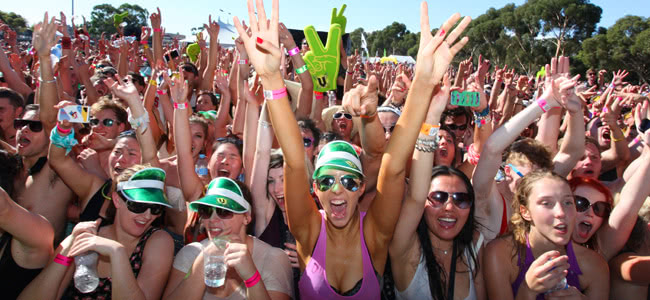Midday welcomed the thousands of Future Music Festival attendees en masse.
Flooding through the gates, the festival-goers were greeted by the dance-driven Stafford Brothers. With their songs interjected periodically by the smooth trumpeting of ‘Timmy Trumpet’, pursued each time with unreservedly drunk applause, the Stafford Brothers announced the opening of the festival with a jumping enthusiasm.
Now veterans to FMF, this drunken reaction to their performance must have come as no surprise to the musicians, and the crowd’s impassioned reception was a warm welcome back to the band.
No longer simply for lovers of DJ sets, Future has grown into its namesake – filling the genre gaps with both rising and settled musicians from a far wider range of musical categories than in previous years.
With an anomalous lineup that bled into rock, pop, hip hop and even indie, as well as the aforementioned electronic, the slow spread of Future’s evolution into a more diverse festival showed invitations to artists such as Gypsy & The Cat, Steve Aoki, The Stone Roses, Avicii, and even Korean superstar Psy.
Gathering with semi-reluctance under the steaming 2pm sun, fans of the English-born Ellie Goulding began flocking towards the Mazda Mariachi stage.
Making full use of the loop pedal, Goulding layered her vocals to match her records with a complete ease. Finishing on a high, with “Lights” and “Starry Eyed” bringing her set to an end, she thanked the sweltering onlookers and left.
The sweeping orchestral extravagance of fun. followed. Easily drawing in the enthused viewers with their exuberant anthems, often weighed with undercurrents of dark tones, fun. lived up to their title.
Hopping around the stage, frontman Nate Ruess was untiring in his recital and reflected this excitement onto the assembly below. The final three numbers, “Barlights”, “We Are Young” and “Some Nights,” each had the collective listeners dancing and singing along with as much dedication as Ruess himself.
Waves of people began to fluctuate between the stages after the late announcement that Azealia Banks would not be performing (instead, A-Trak filled both her set time and his own), with many stumbling towards the stage where Steve Aoki was playing or to shaded areas as they waited for the headlining acts.
Back on the Mazda stage, The Temper Trap began to set up as the area teems with twenty-somethings lining up across the barrier. With their melodies, each slowly rising and descending in smoky reveries reminiscent of musical heavyweights Coldplay, this Australian rock band proudly exhibited a plush koala that hung tightly to the microphone.
Building towards the pervasive “Sweet Disposition”, Dougy Mandagi’s vocals breathed energy into the core of their lyrics and illustrated how The Temper Trap had earned their position as one of the main acts for the day.
As hundreds of older rock aficionados swam towards the front of the stage – a signal that the time for The Stone Roses was fast approaching – many of the younger generation wandered away to peruse the food tents or one of the five alternate stages.
Stringing out guitar solos and stretched jams throughout a number of their tunes, The Stone Roses’ set overflowed with a full, nineties ambience. However, the heavy shadow of their fame acted more as a distraction to their current performance – with constant comparisons to their younger talent lagging behind singer Ian Brown’s psychedelic vocals.
Regardless, their set, bordered by the song “I Wanna Be Adored” and culminating in “I Am The Resurrection”, was a vivid highlight and the incredible talent of guitarist John Squire was not wasted on the devoted Roses fanatics that had braved the festival for their performance alone.

As strips of lasers began cutting through the fog that was blanketing the audience in smoky colours, the highly anticipated British quartet Bloc Party strutted into view.
As the beating of the lights found harmony within the rhythm of the songs, frontman Kele Okereke crashed through fan favourites “Hunting for Witches”, “One More Chance”, “Helicopter” (preluded by a brief cover of Rihanna’s “We Found Love”), “Banquet”, “Positive Tension” and “This Modern Love”.
Okereke’s charmingly smug smile seemed to act as a catalyst for the swooning audience members to cry out their adoration for him, and was displayed after each hit was sung in chorus by the pulsing crowd.
Though their music lacked some of the clarity of their records, with notes missing or vocals out, this merely added a layer of sincerity to the tunes.
Rather than taking away from the buzzing vitality of the set, this laxity in the performance drew in a sense of wild comfort to the headlining act.
Dripping with sweat and the last fraction of energy still remaining in their systems, the festival congregation dispersed out of the parklands and onto the road. With wasted grins and heavy movements, the exhausted gathering headed home mostly shirtless, sunburnt, and contented.
Though the underlying coarseness of a few of the attendees may subtract from the overall appeal of the festival, with guests that are sometimes less attracted by the music and more by the infamously high usage of narcotics and alcohol, FMF is still one of the most representative festivals of mainstream music at present.
Not disappointing the paying customers, Future was a wide insight into the past year of commercial radio in Australia and is continuing to extend its target demographic in rapid motions.

































